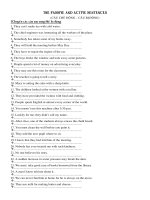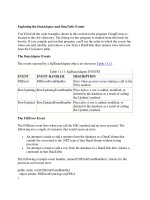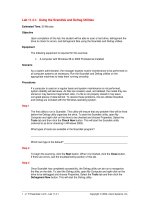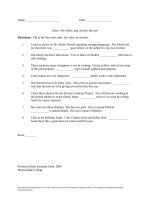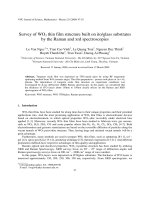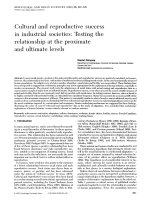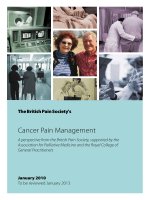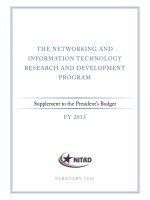ASSESSMENT OF THE BENEFITS OF EXTENDING THE TROPICAL RAINFALL MEASURING MISSION A PERSPECTIVE FROM THE RESEARCH AND OPERATIONS COMMUNITIES doc
Bạn đang xem bản rút gọn của tài liệu. Xem và tải ngay bản đầy đủ của tài liệu tại đây (1.25 MB, 116 trang )
Committee on the Future of the Tropical Rainfall Measuring Mission
Board on Atmospheric Sciences and Climate
Division on Earth and Life Studies
ASSESSMENT OF THE BENEFITS OF
EXTENDING THE
TROPICAL RAINFALL
MEASURING MISSION
A PERSPECTIVE FROM THE RESEARCH AND OPERATIONS COMMUNITIES
INTERIM REPORT
THE NATIONAL ACADEMIES PRESS 500 Fifth Street, NW Washington, DC 20001
NOTICE: The project that is the subject of this report was approved by the Governing
Board of the National Research Council, whose members are drawn from the councils of
the National Academy of Sciences, the National Academy of Engineering, and the Insti-
tute of Medicine. The members of the committee responsible for the report were chosen
for their special competences and with regard for appropriate balance.
Support for this project was provided by the National Aeronautics and Space Administra-
tion under Contract No. NASW-01001. Any opinions, findings, and conclusions or rec-
ommendations expressed in this publication are those of the author(s) and do not neces-
sarily reflect the views of the organizations or agencies that provided support for the
project.
International Standard Book Number 0-309-10282-0
Additional copies of this report are available from the National Academies Press, 500
Fifth Street, N.W., Lockbox 285, Washington, D.C. 20055; (800) 624-6242 or (202) 334-
3313 (in the Washington metropolitan area); Internet, .
Copyright 2006 by the National Academy of Sciences. All rights reserved.
Printed in the United States of America
The National Academy of Sciences is a private, nonprofit, self-perpetuating society of
distinguished scholars engaged in scientific and engineering research, dedicated to the
furtherance of science and technology and to their use for the general welfare. Upon the
authority of the charter granted to it by the Congress in 1863, the Academy has a mandate
that requires it to advise the federal government on scientific and technical matters. Dr.
Ralph J. Cicerone is president of the National Academy of Sciences.
The National Academy of Engineering was established in 1964, under the charter of the
National Academy of Sciences, as a parallel organization of outstanding engineers. It is
autonomous in its administration and in the selection of its members, sharing with the
National Academy of Sciences the responsibility for advising the federal government.
The National Academy of Engineering also sponsors engineering programs aimed at
meeting national needs, encourages education and research, and recognizes the superior
achievements of engineers. Dr. Wm. A. Wulf is president of the National Academy of
Engineering.
The Institute of Medicine was established in 1970 by the National Academy of Sciences
to secure the services of eminent members of appropriate professions in the examination
of policy matters pertaining to the health of the public. The Institute acts under the re-
sponsibility given to the National Academy of Sciences by its congressional charter to be
an adviser to the federal government and, upon its own initiative, to identify issues of
medical care, research, and education. Dr. Harvey V. Fineberg is president of the Institute
of Medicine.
The National Research Council was organized by the National Academy of Sciences in
1916 to associate the broad community of science and technology with the Academy’s
purposes of furthering knowledge and advising the federal government. Functioning in
accordance with general policies determined by the Academy, the Council has become
the principal operating agency of both the National Academy of Sciences and the Nation-
al Academy of Engineering in providing services to the government, the public, and the
scientific and engineering communities. The Council is administered jointly by both Acad-
emies and the Institute of Medicine. Dr. Ralph J. Cicerone and Dr. Wm. A. Wulf are chair
and vice chair, respectively, of the National Research Council.
www.national-academies.org
v
COMMITTEE ON THE FUTURE OF THE
TROPICAL RAINFALL MEASURING MISSION (TRMM)
EUGENE RASMUSSON (Chair), University of Maryland (retired), College
Park, Maryland
V. CHANDRASEKAR, Colorado State University, Fort Collins, Colorado
CAROL ANNE CLAYSON, Florida State University, Tallahassee, Florida
JEFFREY D. HAWKINS, Naval Research Laboratory, Monterey, California
KRISTINA B. KATSAROS, National Oceanic and Atmospheric
Administration (retired), Freeland, Washington
M. PATRICK MCCORMICK, Hampton University, Hampton, Virginia
MATTHIAS STEINER, Princeton University, Princeton, New Jersey
GRAEME L. STEPHENS, Colorado State University, Fort Collins, Colorado
CHRISTOPHER S. VELDEN, University of Wisconsin, Madison, Wisconsin
RAY A. WILLIAMSON, George Washington University, Washington, D.C.
NRC Staff
PAUL CUTLER, Study Director
LEAH PROBST, Research Associate
ROB GREENWAY, Senior Program Assistant
vi
BOARD ON ATMOSPHERIC SCIENCES AND CLIMATE
ROBERT J. SERAFIN (Chair), National Center for Atmospheric Research,
Boulder, Colorado
M. JOAN ALEXANDER, NorthWest Research Associates/CORA, Boulder,
Colorado
FREDERICK R. ANDERSON, McKenna Long & Aldridge LLP,
Washington, D.C.
MICHAEL L. BENDER, Princeton University, New Jersey
ROSINA M. BIERBAUM, University of Michigan, Ann Arbor
MARY ANNE CARROLL, University of Michigan, Ann Arbor
CAROL ANNE CLAYSON, Florida State University, Tallahassee
WALTER F. DABBERDT, Vaisala Inc., Boulder, Colorado
KERRY A. EMANUEL, Massachusetts Institute of Technology, Cambridge
DENNIS L. HARTMANN, University of Washington, Seattle
PETER R. LEAVITT, Weather Information Inc., Newton, Massachusetts
JENNIFER A. LOGAN, Harvard University, Cambridge, Massachusetts
VERNON R. MORRIS, Howard University, Washington, D.C.
F. SHERWOOD ROWLAND, University of California, Irvine
THOMAS H. VONDER HAAR, Colorado State University/CIRA, Fort
Collins
ROGER M. WAKIMOTO, National Center for Atmospheric Research,
Boulder, Colorado
Ex Officio Members
ANTONIO J. BUSALACCHI, JR., University of Maryland, College Park
ERIC F. WOOD, Princeton University, New Jersey
NRC Staff
CHRIS ELFRING, Director
PAUL CUTLER, Senior Program Officer
AMANDA STAUDT, Senior Program Officer
IAN KRAUCUNAS, Associate Program Officer
CURTIS MARSHALL, Program Officer
CLAUDIA MENGELT, Associate Program Officer
ELIZABETH A. GALINIS, Research Associate
LEAH PROBST, Research Associate
ROB GREENWAY, Senior Program Assistant
KATIE WELLER, Program Assistant
DIANE GUSTAFSON, Administrative Coordinator
ANDREAS SOHRE, Financial Associate
vii
This report was originally released in December 2004 in prepublication form
as the first report of a two-phase study to be carried out by the same committee.
The first phase was sponsored by the National Aeronautics and Space Adminis-
tration (NASA) and focused on the Tropical Rainfall Measuring Mission
(TRMM). The second phase was sponsored by the National Oceanic and Atmo-
spheric Administration and focused on the Global Precipitation Measurement
mission. The report of the second phase will be published in a separate volume
in 2006.
A number of significant decisions for TRMM have been made since Decem-
ber 2004. In 2005, NASA approved a waiver of its controlled reentry guidelines
to allow TRMM to operate beyond the minimum fuel point required for a con-
trolled reentry into Earth’s atmosphere. In advance of the 2005 NASA Senior
Review of 12 Earth science missions, NASA’s TRMM team proposed to extend
TRMM.
1
NASA’s Goddard Space Flight Center was directed to continue TRMM
science operations through fiscal year 2009, and TRMM may be further extend-
ed as a result of a future NASA Senior Review.
As of the publication of this report, the TRMM spacecraft and instruments
are in excellent condition and are fully operational.
2
TRMM has enough fuel to
operate until approximately 2012.
June 2006
Prologue
1
The TRMM Senior Review Proposal is available online at />Events/TRMMSeniorProp_1.pdf [accessed May 11, 2006].
2
As mentioned in Chapter 1, Box 1-1, the Clouds and Earth Radiant Energy System instrument
failed shortly after launch. In 2002, one of the two Solar Array Drive Actuators lost sun-tracking
function, leading to slightly less available power for the spacecraft but sufficient power for nominal
operations of all working instruments. For up-to-date TRMM information and operational status,
visit the mission Website at .
ix
This report has been reviewed in draft form by individuals chosen for their
diverse perspectives and technical expertise, in accordance with procedures ap-
proved by the National Research Council’s Report Review Committee. The pur-
pose of this independent review is to provide candid and critical comments that
will assist the institution in making its published report as sound as possible and
to ensure that the report meets institutional standards for objectivity, evidence,
and responsiveness to the study charge. The review comments and draft manu-
script remain confidential to protect the integrity of the deliberative process. We
wish to thank the following individuals for their review of this report:
Phillip Arkin, University of Maryland, College Park
Peter Bauer, European Centre for Medium-Range Weather Forecasts,
Reading, Berkshire, UK
Russell Elsberry, Naval Postgraduate School, Monterey, California
Roger Pielke, Jr., University of Colorado/CIRES, Boulder
Amanda Preble, Naval Pacific Meteorology and Oceanography Center,
Pearl Harbor, Hawaii
Roger Wakimoto, University of California, Los Angeles
Although the reviewers listed above have provided constructive comments
and suggestions, they were not asked to endorse the report’s conclusions or
recommendations, nor did they see the final draft of the report before its release.
The review of this report was overseen by Robert Dickinson, Georgia Institute of
Technology, and Carl Wunsch, Massachusetts Institute of Technology. Appoint-
ed by the National Research Council, they were responsible for making certain
that an independent examination of this report was carried out in accordance
with institutional procedures and that all review comments were carefully con-
sidered. Responsibility for the final content of this report rests entirely with the
authoring committee and the institution.
Acknowledgments
xi
EXECUTIVE SUMMARY 1
1 INTRODUCTION 11
Scope of the Report, 11
Audience for the Report, 12
Information Gathering and Workshop Dimensions, 12
History of the Tropical Rainfall Measuring Mission, 13
Global Precipitation Measurement Mission, 13
2 DECISION CONTEXT 17
Introduction, 17
Elements of the TRMM Decision Context, 17
Cost, 18
Risk, 20
Findings, 22
3 ACHIEVEMENTS OF TRMM TO DATE 25
Introduction, 25
Effect of TRMM, 26
Uniqueness of TRMM, 27
Longevity and Status of TRMM Sensors and Spacecraft, 28
Contributions of TRMM to Research, 29
Contributions of TRMM to Operations, 32
Operational Community Just Beginning to Adopt PR Data, 39
Findings, 40
Contents
xii CONTENTS
4 ANTICIPATED CONTRIBUTIONS OF TRMM 43
Introduction, 43
Anticipated Contributions when Controlled Reentry Is Still Possible, 44
Anticipated Contributions beyond the Fuel Point (In Addition to
What Is Gained While Controlled Reentry Is Still Possible), 53
Conclusions, 58
Recommendation, 60
REFERENCES 61
APPENDIXES
A Committee Biographies 69
B Statement of Task 75
C Workshop Agenda 77
D Workshop Participants and Other Contributors 79
E Letter from World Climate Research Programme/WMO to
Administrator O’Keefe (NASA) and Dr. Yamanouchi
(JAXA), July 6, 2004 81
F Letter from Rep. Boehlert to Dr. Marburger, July 22, 2004 84
G Letter from Rep. Lampson to President Bush, July 23, 2004 86
H Letter from Vice Admiral Lautenbacher to Administrator
O’Keefe, July 23, 2004 88
I Letter from Administrator O’Keefe to Vice Admiral Lautenbacher,
August 3, 2004 90
J Abbreviations 93
K Examples of Improvements in Tropical Cyclone Nowcasting
Gained from TRMM 96
1
The National Aeronautics and Space Administration (NASA), in coopera-
tion with the Japan Aerospace Exploration Agency (JAXA), launched the Tropi-
cal Rainfall Measuring Mission (TRMM) in 1997. Designed as a minimum three-
year mission with the goal of five years duration, TRMM has been collecting
data for seven years, in large part due to the reliability of its sensors and the high
quality of their measurements. Although initially intended as a purely research-
oriented mission, TRMM now is used in operational applications such as hurri-
cane forecasting because data from its suite of complementary sensors are unique
and available in near real time. In the United States TRMM data are used opera-
tionally by the Joint Typhoon Warning Center, the National Center for Environ-
mental Prediction, and the National Hurricane Center, among others. Interna-
tionally the data are used operationally by entities such as JAXA, the European
Centre for Medium-Range Weather Forecasts, and the World Meteorological
Organization tropical cyclone warning centers.
In July 2004 NASA announced that it would finally terminate TRMM in
August 2004. At the request of the National Oceanic and Atmospheric Adminis-
tration (NOAA), and with additional urging from others in the scientific and
operational user community and the White House (see Appendixes E through
H), NASA agreed to continue TRMM operations through the end of the hurri-
cane season and until the end of 2004 (see Appendix I). But many users hope
that the mission will be extended even longer, setting the stage for a difficult
decision.
A further extension of TRMM beyond 2004 will pit financial constraints
against the operational and scientific benefits of continuing; that is, are the bene-
fits greater than the costs and can the necessary funds be secured? The scenario
Executive Summary
2 ASSESSMENT OF THE BENEFITS OF EXTENDING TRMM
becomes more complicated if the mission is extended beyond late 2005. The
TRMM spacecraft is sufficiently large that it will not burn up completely on
reentry. Thus NASA will face a second decision point in roughly December
2005 when it must weigh in the element of the additional risk to life and proper-
ty. For this second decision NASA must choose whether to (1) use TRMM’s
remaining fuel to conduct a controlled reentry into the atmosphere that directs
the remains of the satellite into the ocean far from human settlements
1
or (2)
continue TRMM operation until the fuel runs out in 2010 or 2011 and accept the
added risk of an uncontrolled reentry because of the operational and scientific
benefits of doing so.
THE ROLE OF THE NATIONAL ACADEMIES
In August 2004 NASA Administrator Sean O’Keefe requested that the Na-
tional Academies provide advice on the anticipated scientific and operational
contributions from extending TRMM beyond 2004. The charge to the Commit-
tee on the Future of the Tropical Rainfall Measuring Mission in the first phase of
its work was to conduct a workshop and prepare an interim report to be delivered
in December 2004 on how best to use the remaining TRMM spacecraft life. The
Academies were able to begin the study process in October 2004, and immedi-
ately assembled the committee and planned an information-gathering workshop.
The committee and workshop participants were asked to consider
• scientific and research contributions of TRMM to date and those expect-
ed if TRMM is continued;
• operational contributions of TRMM to date and those expected if TRMM
is continued;
• assessment of expected benefits of continuing TRMM operation until (1)
fuel is depleted to the level needed for a controlled reentry (around December
2005), and (2) all fuel is depleted (estimated to be 2010-2011).
A second phase of the committee’s work will focus on needs for satellite-
based measurements of tropical rainfall beyond TRMM (see Appendix B).
The committee hosted its phase I workshop in Washington, D.C., on No-
vember 8, 2004,
2
and subsequently drew on information and discussions from
the meeting and other written inputs and information sources to address its task
for phase I.
1
In this scenario controlled reentry would be in 2008 after the satellite had drifted to a lower orbit
for roughly two years.
2
See for presentations from the workshop.
EXECUTIVE SUMMARY 3
FINDINGS
NASA and JAXA are to be commended on the highly successful TRMM
satellite whose achievements and longevity have exceeded even the optimistic
expectations at the time of launch. These agencies are also to be commended for
their visionary actions to extend the lifetime of TRMM beyond the original
anticipated maximum length of the mission thereby enhancing the value of the
data from TRMM to science and operations. The committee found the following:
• TRMM has two unique attributes that make it ideal for observing tropical
rainfall systems: (1) its suite of complementary observing instruments, and (2)
its orbital characteristics.
1. The Precipitation Radar (PR) is the only precipitation radar in space
and provides direct, fine-scale observations of the three-dimensional struc-
ture of precipitation systems. The combination of PR and Lightning Imag-
ing Sensor (LIS) observations provides a measure of convective intensity.
3
The combination of PR, TRMM Microwave Imager (TMI), and Visible and
Infrared Scanner observations from the same platform serves, in effect, as a
“Rosetta Stone” for cross-calibration of the indirect estimates of precipita-
tion from microwave, visible, and infrared observations.
2. The TRMM orbit (low altitude, non-sunsynchronous, precessing,
35-degree tropical inclination) provides sampling in the tropics that is far
more frequent, and far more spatially comprehensive than that obtained from
standard polar orbiter satellites.
• TRMM has achieved its original science goals and produced a greater
than expected range of scientific results in
1. climate and weather research (e.g., a reliable seven-year climatolo-
gy of the mean annual tropical rainfall and its interannual and diurnal cy-
cles; fundamental new information on the synoptic climatology of tropical
weather systems, e.g., the first detailed precipitation and latent heating pro-
files throughout the tropics and subtropics, first detailed convective and
stratiform rainfall structure, and a description from space of the fine-scale
structure of rainfall systems that can only be determined from the PR data;
understanding of how sea surface temperature patterns modify precipitation
through air-sea interaction; quantitative documentation of precipitation pat-
terns; mapping sea surface temperature through clouds for improved climate
3
The TRMM Microwave Imager also can gauge convective intensity, but the PR and LIS data are
principally used.
4 ASSESSMENT OF THE BENEFITS OF EXTENDING TRMM
records; demonstrating the effect of pollution and other human influences
on precipitation formation); and
2. applied research (e.g., a wealth of climatological and diagnostic
information on tropical rainfall; insight on the physical processes of precip-
itation formation; unique, fine-scale information on hurricane and typhoon
structure linked to rapid intensification; calibration of a long-term satellite
precipitation dataset and multisatellite three-hour analyses; experimental
tropical cyclone forecast methods; enhanced sea surface temperature now-
casting applications using TMI data; integration of TRMM data into fore-
cast model initialization procedures; enhanced understanding of tropical cy-
clone inner eyewall dynamics and tropical cyclone intensity).
• Since 1998, TRMM has provided near-real-time information for opera-
tional purposes. Data from the TMI sensor are most often used. There are four
principal applications: (1) monitoring and predicting the future behavior of trop-
ical cyclones, (2) estimating rainfall, (3) predicting weather, and (4) monitoring
of climate variability (precipitation and sea surface temperature). Many organi-
zations and individuals have invested in bringing TRMM data into the operation-
al environment because of the unique aspects of TRMM’s orbit and sensor suite.
This reflects their professional judgment of the value of doing so based on their
experiences of improvements in such things as accuracy of center fixes for trop-
ical cyclones and prediction of storm intensity. Nonetheless, the effect of TRMM
data on operational applications has not been widely quantified because the data
record is too short for meaningful statistical analysis and no one has done control
experiments wherein the TRMM data are eliminated and the analysis is rerun.
Further, the socioeconomic effects on end-users of improved forecasts have not
been quantified.
In the United States TRMM data are used in operations by NOAA organiza-
tions (e.g., Tropical Prediction Center, National Centers for Environmental Pre-
diction, Satellite Analysis Branch, Aviation Weather Center, Climate Prediction
Center, National Climate Data Center) and the Department of Defense (e.g.,
Joint Typhoon Warning Center, Air Force Weather Agency, Fleet Numerical
Meteorology and Oceanography Center, Naval Research Laboratory). TRMM
data are used internationally for operations by World Meteorological Organiza-
tion centers throughout the tropics for monitoring and forecasting tropical cy-
clone activity. Groups in Japan and Europe have begun using TRMM data in
numerical weather prediction models. Because TRMM data are already being
used operationally (which does not fit with NASA’s primary focus of research
and exploration) NASA has sought partnerships with other agencies to fund
extension of TRMM. Thus, determining the future of TRMM has become a
multi-agency issue.
• TRMM’s potential to help improve forecasts—especially through in-
creased use of PR data in models—has not been fully realized because of
EXECUTIVE SUMMARY 5
1. the PR data having only recently become available in near real time
to the broader community outside of NASA and JAXA,
2. the new and unique nature of the PR data and the learning required
to exploit them,
3. the perceived experimental nature and finite lifetime of the PR, and
4. the lack of sophistication in the representation of cloud and precip-
itation physics in current operational forecast models and global climate
models such that they cannot yet take advantage of the native resolution of
the PR data.
• The TRMM satellite and its sensors remain in excellent condition. There
is every reason to believe that they will continue to operate well for the next few
years.
• NASA will incur costs for operating the TRMM satellite through 2007
even if the mission is terminated in December 2004, because of the time it takes
for the spacecraft to drift down to an appropriate altitude for controlled reentry.
These costs exceed the amount currently in NASA’s budget for TRMM. The
additional cost of extending TRMM from December 2004 to November 2005 is
approximately $4 million. It is NASA’s practiced policy to try to recover its
costs of mission extension from related research programs. In the case of TRMM,
these extra costs would likely have to be borne by NASA’s precipitation re-
search budget, which is around $16 million per year. However, it is outside this
committee’s charge to assess the effects on other satellite operations, missions,
and research budgets of NASA bearing the entire cost of extending TRMM,
though such an assessment is part of the overall decision context.
• The most recent analyses of the risks from uncontrolled reentry are those
reported in 2001 (Pielke et al., 2001) and 2002 (Martin, 2002) (see Chapter 2),
and the committee is unaware of any subsequent changes to the conclusions.
Although the risk from uncontrolled reentry is part of the overall decision con-
text, the committee is neither tasked to assess this risk nor does it have the
expertise to do so.
CONCLUSIONS
• The material in this National Research Council report provides science
and operations information needed as input for a qualitative evaluation of the
balance between the risk inherent with an uncontrolled reentry and the contribu-
tion through operations and research to the protection of life and property of an
extension of the TRMM mission. Extension of the mission to at least late 2005
will provide time for further examination of the relevant issues.
• There are persuasive reasons to believe that significant contributions of
TRMM to operations and science will continue if the mission is extended. The
committee’s conclusions about operational and research benefits of extending
6 ASSESSMENT OF THE BENEFITS OF EXTENDING TRMM
TRMM to the fuel point in approximately December 2005 and beyond are com-
piled in Table ES-1.
• From the perspective of anticipated research contributions, TRMM is
worth continuing for six primary reasons.
1. TRMM provides a unique complement of measurements. Specifi-
cally, the PR, the passive microwave imager, and the visible and infrared
instruments provide a powerful overlap of precipitation, cloud, and water
vapor measurements and the LIS helps isolate intense convective cells. The
TMI permits sea surface temperature measurement through clouds at high
spatial resolution. Continuation of the mission is vital to the future develop-
ment of spaceborne PR technology, especially in the evaluation of radar
technology life cycle.
2. Mission extension creates the opportunity for cross-calibration, val-
idation, and synergy with sensors on future missions, such as CloudSat and
the A-Train satellite series, the National Polar-orbiting Operational Satellite
System’s Conical Scanning Microwave Imager/Sounder, and the Global Pre-
cipitation Measurement core satellite and other constellation satellites.
3. TRMM’s unique low-inclination, low-altitude, precessing orbit en-
hances science by providing unique spatial and temporal information that
fills gaps in data from other current and upcoming polar-orbiting satellite
sensors.
TABLE ES-1 Anticipated Operational and Research Contributions due to
Extending TRMM to the Fuel Point (approximately December 2005) and
Beyond
Anticipated Contributions of TRMM Additional Anticipated Contributions of
Up to the Fuel Point (when controlled TRMM Beyond the Fuel Point (i.e., in
reentry is still possible) addition to what is gained up to the fuel point)
OPERATIONS OPERATIONS
• Another year of TMI and PR data • Technology demonstration of the
for tropical storm monitoring and endurance of the first precipitation radar
forecasting** inspace*
• Another year of TMI data for • Improved forecasts from the operational
numerical weather prediction** assimilation of PR and TMI data into
• Another year of PR and TMI data for weather and climate prediction models**
enhancing near-real-time rainfall
products**
• Another year of lightning data for
air traffic advisories*
• Realizing the potential to use PR
as a global rainfall reference standard*
EXECUTIVE SUMMARY 7
RESEARCH RESEARCH
• Overlap with CloudSat radar • Unique opportunities to enhance field
operations and the A-Train satellite experiment (AMMA)**
series** • Developing the next generation hurricane
• Overlap with the Coriolis WindSat forecast model**
sensor** • Seamless transition into the Global
• Unique opportunities to enhance field Precipitation Measurement (GPM)
experiments (TCSP, TEXMEX-II)** mission*
• Unique opportunities to enhance • Realization of a prototype GPM-like
international research programs operation*
(GEWEX, THORPEX, Hurricane • Avoiding researchers being ill-prepared
Field Program)** for GPM**
• TRMM’s Precipitation Radar provides • Better characterization of interannual
a calibration reference for the current variability and the El Niño-Southern
GPM mission-like Oscillation cycle*
constellation of microwave satellite
sensors**
• TRMM is a catalyst for tropical
cyclone research (e.g., research on
convective bursts, tropical cyclone
eyewall replacement cycles, improved
forecasting of inland flooding during
hurricanes)**
• Longer TRMM record needed for
tropical cyclone forecasting*
• Longer TRMM record needed for
climate research*
• Foster improving moist physics
parameterization for climate models,
numerical weather prediction, and
related assimilation systems by
evaluating models of clouds and
precipitation physics*
NOTE: See Appendix J for acronym definitions for field experiments and programs. We use a single
asterisk to differentiate applications that use TRMM data only, or as the primary component of a
research or operational activity, from those that use TRMM data as a complementary component of
an operational or research activity (marked with a double asterisk). There is a gray area between
these two categories, but the distinction serves as a first-order attempt to differentiate between essen-
tially stand-alone contributions and complementary but still unique contributions of TRMM.
TABLE ES-1 Continued
Anticipated Contributions of TRMM Additional Anticipated Contributions of
Up to the Fuel Point (when controlled TRMM Beyond the Fuel Point (i.e., in
reentry is still possible) addition to what is gained up to the fuel point)
8 ASSESSMENT OF THE BENEFITS OF EXTENDING TRMM
4. TRMM data will enhance field experiments and programs (e.g.,
TCSP, AMMA, GEWEX, THORPEX, TEXMEX-II [see Appendix J for
explanations of program name abbreviations]), tropical cyclone research—
including tropical cyclone forecasting—and development of cloud-resolv-
ing models.
5. A longer record is required to collect enough examples to cover the
parameter space of synoptic variability more fully. For example, over the
first six years of TRMM data, the TMI instrument passes within 750 km of
storm centers during one of every eight orbits, whereas PR observes within
250 km of the center during one of every 25 orbits. The narrow swath of the
PR and the rare occurrence and great variability of tropical cyclone struc-
ture, intensity, and precipitation amount strongly argues for mission exten-
sion to increase sample sizes for statistical analyses.
6. Longer TRMM data records will better characterize tropical sea-
sonal-interannual climate variability in general and the El Niño-Southern
Oscillation (ENSO) cycle in particular. ENSO is the dominant mode of
global interannual climate variability. TRMM provides quantitative ENSO-
related tropical rainfall anomalies that are needed to improve our under-
standing of both the local and remote effects of this phenomenon, and ulti-
mately to make better predictions of its socioeconomic effects in both the
tropics and extratropics.
• TRMM’s reliability combined with the value of TRMM data to opera-
tions shows the satellite’s potential as an operational system. From a perspective
of anticipated operations contributions TRMM is worth continuing for three pri-
mary reasons.
1. TRMM data from the TMI and PR sensors have a demonstrated
capability (for TMI) or potential capability (for PR) to improve the weather
forecasting process, especially for monitoring and forecasting the tracks and
intensity of tropical cyclones and the intensity of rainfall they yield.
2. Continuation of the TMI data stream would enable modelers and
forecasters to continue to improve the overall numerical weather prediction
process (i.e., model development and validation, forecast initialization, and
forecast verification). This includes use of TMI in calibrating similar data
from other microwave sensors and contributes to improved global as well as
tropical precipitation monitoring and prediction.
3. PR data are an underexploited yet unique resource. Having them
available in near real time for an extensive period of time would foster
investment of time and effort to make full use of PR data in the forecasting
process.
EXECUTIVE SUMMARY 9
• Considering the past and expected scientific and operational contribu-
tions presented in this report, important benefits would be obtained if TRMM
were extended until it runs out of fuel. Although the scientific and operational
arguments by themselves point toward maximum extension of the TRMM satel-
lite life, the committee is concerned that there has not been proper consideration
of all three elements of the decision (benefits, costs, and risk). The committee
recognizes that consideration of the associated costs and reentry risks has to be
part of the decision equation, which requires a solution acceptable to both the
user and interagency communities.
RECOMMENDATION
The committee strongly recommends continued operation of TRMM, at least
until such time as a decision on controlled reentry becomes unavoidable. The
additional year can be used to more fully weigh the benefits, costs, and risks.
11
1
Introduction
SCOPE OF THE REPORT
This is the interim report of the Committee on the Future of the Tropical
Rainfall Measuring Mission (TRMM) (see Appendix A). The charge to the com-
mittee in this first phase of its work is to conduct a workshop and prepare an
interim report to be delivered in December 2004 on how best to use the remain-
ing TRMM spacecraft life. In particular, the committee and workshop partici-
pants were asked to consider:
• scientific and research contributions of TRMM to date and those expect-
ed if TRMM is continued;
• operational contributions of TRMM to date and those expected if TRMM
is continued;
• assessment of expected benefits of continuing TRMM operation until (1)
fuel is depleted to the level needed for a controlled reentry (around December
2005) and (2) all fuel is depleted (estimated to be 2010-2011).
A later phase of the committee’s work will focus on needs for satellite-based
measurements of tropical rainfall beyond TRMM (see Appendix B).
The decision context for mission extension has three major components: the
operational and research benefits of extension, financial constraints, and risk to
life and property during satellite reentry. In December 2004 the National Aer-
onatuics and Space Administration (NASA) will weigh the research and opera-
tional benefits against the cost of extending the mission for approximately one
year. If NASA decides to continue TRMM, a second decision point will be
12 ASSESSMENT OF THE BENEFITS OF EXTENDING TRMM
forced in approximately December 2005. At that point the agency will have to
weigh the societal benefits of TRMM against both the additional cost and the
risk of an uncontrolled reentry if the remaining fuel is used to maintain the
satellite’s orbit rather than to guide the spacecraft into the ocean.
The committee’s task focused on the research and operational benefits com-
ponent of the decision. The committee was not tasked to analyze the risk or cost
components, although these components are part of the overall context and thus
laid out in Chapter 2. Chapter 3 describes the achievements of TRMM in re-
search and operations to date and Chapter 4 looks to the potential future research
and operational applications of TRMM. Chapter 4 differentiates between the
potential contributions from a TRMM extension until fuel is depleted to a level
that is still sufficient for a controlled reentry or until all fuel is depleted. A series
of appendixes provides supporting information that is referenced in the body of
the report.
AUDIENCE FOR THE REPORT
The audience for this report includes NASA and the Japan Aerospace Ex-
ploration Agency (JAXA), operational agencies (e.g., the National Oceanic and
Atmospheric Administration [NOAA], Department of Defense agencies), Con-
gress (e.g., House Science Committee), the White House Office of Science and
Technology Policy and Office of Management and Budget, the scientific com-
munity in general, and users in particular.
INFORMATION GATHERING AND WORKSHOP DIMENSIONS
The committee gathered information using four approaches.
1. inviting presentations at a workshop on November 8, 2004 (see Appen-
dix C);
2. promoting and tracking discussion at the workshop (from participants in
the room and on the phone [see Appendix D]);
3. reviewing existing written materials, such as peer-reviewed papers, re-
ports, information from Websites, and letters; and
4. soliciting input to a Website that posed questions relating to the commit-
tee’s phase I task.
The workshop had four sessions (Appendix C) with formal input from 14
people. Approximately 45 people attended the workshop and participated in gen-
eral discussion. Participants from Japan attended on an open phone line. The
formal presentations are available on the Web.
1
1
See />
